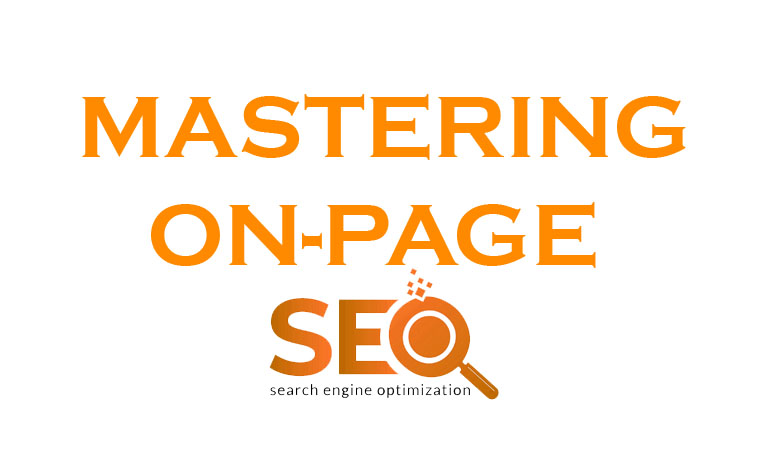Table of Contents
ToggleIntroduction
In the Wide and competitive world of search engine optimization (SEO), on-page optimization stands as a critical pillar for achieving online success. It involves optimizing many elements on your website to improve search visibility, and user experience, and ultimately drive more organic traffic. This blog post will delve into the intricacies of on-page optimization, highlighting its significance and the role it plays in SEO success.

Keyword Research and Targeting
- Understanding the Significance of Keywords in On-Page Optimization Keywords act as the foundation of on-page optimization. They are the words and phrases that users enter into search engines to find information or solutions. By understanding the importance of keywords, you can align your website content with user intent and improve its visibility in search engine results.
- Conducting Keyword Research to Identify Relevant and High-Ranking Keywords Thorough keyword research allows you to identify relevant and high-ranking keywords in your niche. Utilize keyword research tools and analytics to uncover search volumes, competition levels, and user intent. This data will guide you in choosing the most strategic keywords to target.
- Targeting Long-Tail Keywords for More Specific and Targeted Traffic While broad keywords have their place, targeting long-tail keywords offers the advantage of capturing more specific and targeted traffic. Long-tail keywords are longer, more specific search phrases that indicate a higher intent to convert. By incorporating long-tail keywords strategically, you can attract highly relevant visitors who are more likely to engage with your content.
Title Tags, Meta Descriptions, and Headers
- Optimizing Title Tags for Keyword Relevance and User Appeal Title tags are HTML elements that define the title of a webpage. Optimizing title tags involves incorporating relevant keywords while making them appealing to users. A compelling title tag can entice users to click on your website in search results.
- Crafting Compelling Meta Descriptions That Encourage Click-Throughs Meta descriptions provide a brief summary of a webpage’s content. Crafting compelling meta descriptions involves creating concise and engaging descriptions that include targeted keywords. An enticing meta description can significantly improve click-through rates from search engine results pages (SERPs).
- Using Headers (H1, H2, etc.) to Structure Content and Signal Relevancy to Search Engines Headers, marked by HTML tags (H1, H2, etc.), help structure content and improve readability. Search engines use headers to understand the organization and hierarchy of your content. Incorporating keywords into headers can signal relevancy to search engines and assist in better ranking.
URL Structure and Optimization
- Creating Clean and Descriptive URLs That Incorporate Target Keywords URLs should be clean, concise, and descriptive of the webpage’s content. Including target keywords in URLs can help search engines and users understand what the page is about. Avoid lengthy, confusing URLs that hinder readability.
- Optimizing URLs for Readability and User Experience Optimizing URLs involves creating user-friendly links that are easy to read and understand. Use hyphens to separate words in URLs, avoid using special characters or numbers, and keep them as short and relevant as possible.
- Implementing Canonical URLs to Avoid Duplicate Content Issues Canonical URLs are used to resolve duplicate content issues when multiple URLs have similar or identical content. By implementing canonical URLs, you can indicate the preferred version of a webpage, consolidating link equity and preventing content duplication.
Content Optimization and Keyword Placement
- Developing High-Quality and Engaging Content That Aligns With User Intent Creating high-quality and engaging content is paramount for on-page optimization. Understand your target audience’s needs and preferences, and develop content that provides value, answers their questions, and aligns with their search intent.
- Incorporating Target Keywords Naturally Throughout the Content While keywords are essential, it’s crucial to incorporate them naturally and avoid overstuffing. Place keywords strategically in the title, headings, and throughout the body of the content, ensuring they flow naturally and enhance the user experience.
- Utilizing Variations of Keywords to Enhance Semantic Relevance Incorporating keyword variations helps improve semantic relevance and demonstrates a deeper understanding of the topic. Use synonyms, related terms, and long-tail variations of keywords to enrich your content and provide a more comprehensive experience for users.
Internal Linking and Site Structure
- Establishing a Logical and User-Friendly Site Structure A well-organized site structure enhances user experience and helps search engines crawl and index your website efficiently. Organize your content into relevant categories and subcategories, allowing users to navigate seamlessly and find the information they seek.
- Incorporating Internal Links to Improve Navigation and Distribute Link Authority Internal links connect different pages within your website and play a crucial role in distributing link authority. By linking related pages together, you establish a hierarchy and guide search engines to understand the importance and relationships between your content.
- Using Keyword-Rich Anchor Text in Internal Links to Provide Context to Search Engines Anchor text is the visible and clickable text within a hyperlink. Incorporating keyword-rich anchor text in internal links helps search engines understand the context of the linked page. Use descriptive anchor text that accurately reflects the content it links to.
Image Optimization
- Optimizing Image File Names and Alt Tags With Relevant Keywords Images contribute to the overall user experience and can be optimized for SEO. Renaming image files with descriptive names that include relevant keywords and utilizing alt tags provides additional context to search engines and enhances accessibility for visually impaired users.
- Compressing Images for Faster Page Loading Speed Large image files can significantly impact page loading speed, negatively affecting user experience and search rankings. Compressing images reduces file sizes while maintaining visual quality, leading to faster page load times and better overall performance.
- Providing Descriptive Captions and Utilizing Image Sitemaps Adding descriptive captions to images enhances user engagement and helps search engines understand the context of the visuals. Additionally, utilizing image sitemaps enables search engines to discover and index your images more efficiently, increasing their visibility in image search results.
User Experience and Mobile Optimization
- Enhancing Website Usability and User Experience Through Responsive Design A responsive design ensures that your website displays properly and functions optimally across various devices and screen sizes. Prioritize mobile responsiveness, as search engines increasingly favor mobile-friendly websites, and users are increasingly accessing the web via mobile devices.
- Optimizing Page Load Speed for Better Performance on All Devices Page load speed is a critical factor in both user experience and search engine rankings. Optimize your website’s performance by minimizing file sizes, leveraging browser caching, and utilizing content delivery networks (CDNs) to deliver content quickly to users worldwide.
- Implementing Mobile-Friendly Features Like Touch-Friendly Buttons and Readable Fonts Mobile users interact differently with websites, requiring touch-friendly buttons, clear navigation, and readable fonts. Implement mobile-friendly features to enhance usability and ensure a seamless experience for mobile visitors.
Structured Data and Schema Markup
- Implementing Structured Data to Provide Additional Context to Search Engines Structured data, represented by schemas, provides search engines with explicit information about your content. By implementing structured data, you enable search engines to better understand and interpret your website’s content, leading to enhanced search visibility.
- Utilising Schema Markup for Rich Snippets and Improved Search Visibility Schema markup helps enhance search engine results with rich snippets, such as star ratings, reviews, and event information. By leveraging schema markup, you can improve the appearance of your website in SERPs and attract more clicks from users.
- Enhancing SERP Appearance With Structured Data for Better Click-Through Rates Structured data not only provides additional context but also improves the overall appearance of your website in search results. Rich snippets and enhanced SERP features make your listing stand out, increasing click-through rates and driving more organic traffic.
User Engagement Signals
- Encouraging User Engagement Through Clear Calls-to-Action and Interactive Elements Well-placed calls-to-action (CTAs) prompt users to engage further with your content, such as subscribing, sharing, or making a purchase. Use compelling CTAs and interactive elements, such as quizzes or surveys, to encourage user engagement and extend their time on your website.
- Optimizing Page Layout and Design for Easy Readability and Engagement A clean and intuitive page layout contributes to a positive user experience. Optimize your website’s design for easy readability, legible fonts, and appropriate spacing. Consider the use of visual elements, such as images or videos, to enhance engagement and captivate users.
- Monitoring and Improving Bounce Rate, Time on Page, and Other Engagement Metrics Regularly monitor and analyze user engagement metrics, including bounce rate, time on page, and conversions. Identify areas for improvement and refine your content and design to increase user engagement and achieve higher conversion rates.
Tools and Resources for On-Page Optimization
- Overview of SEO Tools for Keyword Research, On-Page Analysis, and Optimization A variety of SEO tools are available to assist with on-page optimization tasks, including keyword research, content analysis, and technical optimization. Explore popular tools like Google Keyword Planner, SEMrush, Moz, and Yoast SEO for valuable insights and optimization guidance.
- Resources and Guides for Staying Up-to-Date With Best Practices in On-Page Optimization SEO is an ever-evolving field, and staying updated with the latest best practices is crucial. Follow reputable SEO blogs, attend webinars, and participate in forums to gain insights from industry experts. Google’s official Webmaster Central Blog is an excellent resource for staying informed about algorithm updates and recommended practices.
Conclusion
On-page optimization plays a fundamental role in boosting your website’s search visibility, attracting organic traffic, and enhancing user experience. By diligently optimizing elements such as keywords, title tags, URLs, content, and user engagement, you can improve your website’s chances of ranking higher in search engine results. Remember to continually monitor and optimize your on-page elements to stay ahead in the competitive SEO landscape and provide a seamless experience for your visitors. On-page optimization, when done right, can pave the way for long-term SEO success.


